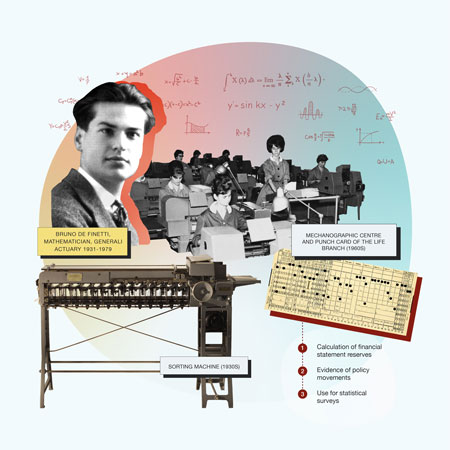Bruno de Finetti, the awkward mathematician
The point of union between human calculation and computerised calculation was a tool invented by an American engineer named Herman Hollerith: a punch card system that made it possible to enter all kinds of information into the machine and speed up a series of calculation operations, assimilations, and data reprocessing. From 1932 Generali, too, began to equip itself with these futuristic machines for the life branch, and one of the most important, esteemed, and brilliant mathematicians of the time was appointed to manage them: Bruno de Finetti (www.brunodefinetti.it).
De Finetti was a man and a mathematician with a very high national and international profile; after his experience at Generali he taught at La Sapienza in Rome, among other universities, first Mathematical Finance and then Probability Calculation.
We asked his daughter, Fulvia de Finetti, for a brief memory of her father, who not only managed the transition from manual to mechanised calculation at Generali, in charge of the “Hollerith department” but, above all, whose knowledge of mathematics and humanity brought prestige to the company.
“In the Hollerith department, all the employees including Dad looked after the machines in silence, because they really made a lot of noise. I remember that Dad organised the work in two shifts to optimise the work and make the machines work as much as possible. I imagine that he divided the employees into two shifts while keeping in mind both the demands of the job and the needs of the employees – it seems to me that they were happy.
“When Dad left Generali, he continued to work as a consultant for many years. Someone once told me that, with his skills, he could have risen to the top of Generali and earned a lot of money. But he had discovered mathematics at the age of 19 and, as he wrote to his mother, he would dedicate his life to mathematics.
“Dad was a person of great integrity: I remember his anger when he read news in the paper about, for example, tomatoes being destroyed. He was angered by the dysfunctions of the state, the bureaucracy. I remember the case of one of his assistants who, on changing positions, had been left without pay for months because the old salary had been stopped immediately.
“The book I dedicated to my father bears the title ‘an uncomfortable mathematician’ because he did not conform to the prevailing attitude of his colleagues. I remember how unbearable he found the faculty meetings or those for professorship contests. It was also uncomfortable for those students who thought they could pass the exam by studying theorems and proofs by heart.
“I have beautiful memories of my Trieste years and am always happy to return to what I still consider my home city. Although it was wartime during my early childhood, I didn’t understand the dangers, and going to the shelter was almost a welcome change. Then came the age of school, friendships, swimming in the sea at the Excelsior in Barcola with Dad, then with schoolfriends at Ausonia. Afternoons skating in the park, and the open-air cinema in summer. Sundays with packed lunches on the Opicina tram; and then, when a second-hand Fiat 1500 joined the family and my parents got their driving licenses, we often went to visit Uncle Gino, a painter, in Corona (Dad’s uncle but I also called him that). At 13, I learned to drive in the meadows in that old 1500.
If I had to define my father with a single word, I would simply say ‘he was a mathematician’.”
HISTORY

Hollerith machines were first introduced in the Generali Head Office in Trieste in 1932 by the life branch. In 1937, a new system was set up which was dedicated to various accounting jobs and all branches, functioning as an independent department.
Rationalisation and modernisation of the systems generated benefits for the entire administrative body of the company: the use of Hollerith machines became an organisational tool for work, and the first reason for the advantages afforded by the Hollerith system derived from the fact that, once the starting data was translated into perforations, it was possible to get all the papers that reported them automatically and quickly grouped, printed, and added up, in any graphic and logical arrangement, without the lengthy timescales and transcription errors associated with manual processing.
In both the administrative and technical fields, Generali demonstrated its ability to keep up with the dynamic pace of the time, equipping itself with the most advanced technologies useful for its operations and able to respond to the typical features of its daily problems, customising them for the maximum benefit of the company and its policyholders, thanks to the contribution of leading figures already working for the company, like Bruno de Finetti. The new machines enabled Generali to consolidate its groundbreaking role in the field of statistics and automation, demonstrating once more that its genetic heritage includes the ability to innovate, in terms of interpreting changes and emerging needs, making them its own, and transforming them into solutions, making use of the best existing technology.
